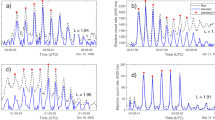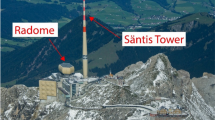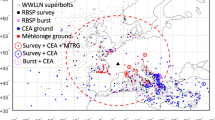Abstract
DURING the last few years we have made, on the roof of King's College, London, a series of observations on the rapid variations of the earth's electric field associated with thundercloud discharges, using a Wilson sphere as the conductor exposed to the earth's field, and a cathode ray oscillograph, with photographic registration, as the recording instrument1. In this way we have been able to follow the evolution of an atmospheric wave-form from the discontinuous change of field associated with near flashes to the type of radiation field, with its high-frequency detail, observed at greater distances. These experiments, together with allied investigations carried out at the Slough Radio Research Station of the National Physical Laboratory, were described at the recent meeting of the International Scientific Radio Union in London (September 1934).
This is a preview of subscription content, access via your institution
Access options
Subscribe to this journal
Receive 51 print issues and online access
$199.00 per year
only $3.90 per issue
Buy this article
- Purchase on SpringerLink
- Instant access to full article PDF
Prices may be subject to local taxes which are calculated during checkout
Similar content being viewed by others
References
Chapman, NATURE, 131, 620April 29, 1933.
Author information
Authors and Affiliations
Rights and permissions
About this article
Cite this article
APPLETON, E., CHAPMAN, F. The Lightning Flash as Source of an Atmospheric. Nature 134, 968 (1934). https://doi.org/10.1038/134968a0
Issue date:
DOI: https://doi.org/10.1038/134968a0
This article is cited by
-
The Effect of Sunset on Atmospherics
Proceedings of the Indian Academy of Sciences - Section A (1941)
-
Nature of Atmospherics
Nature (1935)



